Totsiens, Hoe gaan dit ? That’s how we say it in Afrikaans !
Between oceans, mountains, deserts, and flowers, prosperous cities and townships, the Republic of South Africa is a nation made up of the colors of the rainbow. The vineyards and beaches of the Cape, the Cederberg peaks, the dry land of the Namakwa, the red dunes of the Kalahari, all this is only a glimpse of the great and beautiful, but also fragile, diversity of the country. Make the most of your discovery, get rid of your preconceived notions about South African history and society, take your binoculars, try to spot “Cheetah” – no, not the faithful companion of Tarzan – and prepare to travel in an ever-surprising country… surprising in its geography as well as in its diverse flora and fauna !
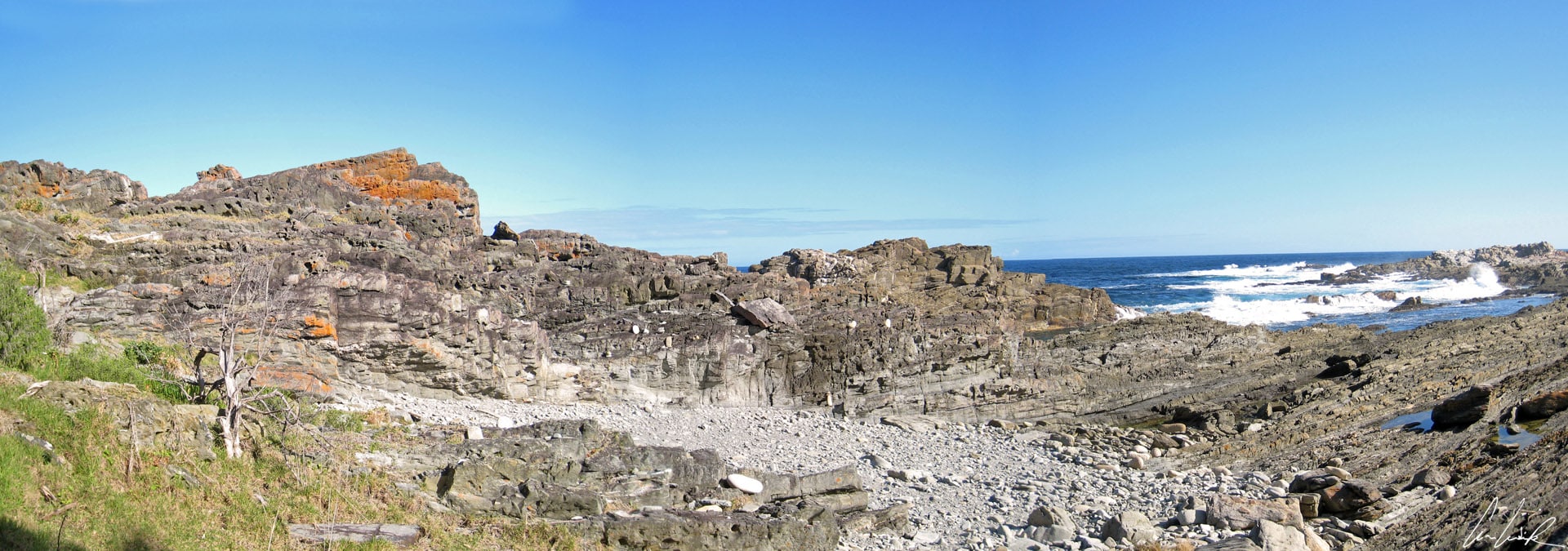
Tsitsikamma National Park, rocky shore
The Tsitsikamma National Park is nestled on the south coast of the Indian Ocean. In 2009 it was combined with the Wilderness National Park and surrounding lands to form the Garden National Route Park. Tsitsikamma is a Khoisan word meaning “place of abundant water“… One is at first struck by the thousand-year-old rocky shore, formed of limestone and quartz, bordering the Indian Ocean. The view of the dramatic coastline from the Tsitsikamma National Park is spectacular, especially when the Ocean is rough and powerful waves break with ferocity upon the rocky shore. In this rocky setting, we encounter a close cousin of the elephant, but one without a trunk ! Hare-sized, the Rock Damask (called “Dassie” in South Africa and “Pimbi” in Swahili) resembles a big Marmot. It spends most of its time lazing in the sun and playing with others of its kind. A hard life for a Marmot on the beach ! Although small, hairy, and without a trunk this animal is, strange as it may sound, genetically close to the elephant. But it is all in the DNA ! Numerous hiking trails, including the famous Otter Trail (26 miles), make it possible to discover the park.
Besides the magnificent coastal landscape, this natural park includes seven rivers, of which the Stroms River and the Bloukrans are the most famous. In these cormorants and otters bathe and play. The park has deep ravines and a dense endemic forest, including 116 species of giant trees, notably the yellow wooden virgin of Outeniqua. The Park is also home to the smallest antelope in South Africa, the Blue Duiker which reaches 35 cm at its shoulders and weighs about 9 pounds. Its skin is brown with a bluish reflection… hence its name ! And from the same family there are some close relatives of more impressive size that we ran into on our way back.
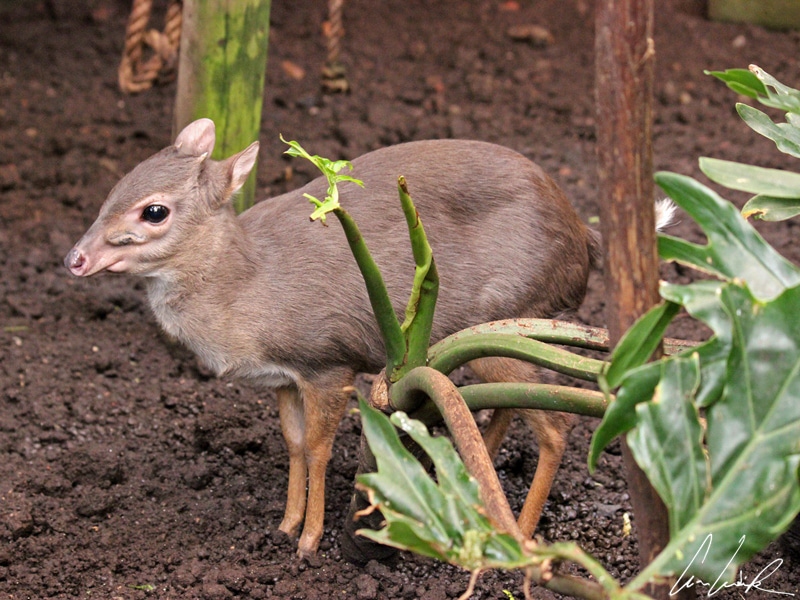
Blue Duiker
On the way to the city of Knysna (pronounced “ni-zna”), well-known, at least to amateurs of the round ball and supporters of the French football team ! Knysna is also a Khoikhoi word that comes from Central Africa and means “a vast place of water”… Nyanga and Nyassa are two other lakes with similar names. The town of Knysna is especially famous for its 10-day oyster festival in late June early July. No visit is complete without savoring this succulent seafood, served with locally brewed beer… The town nestles at the edge of a magnificent, large warm-water estuary, known as the Knysna lagoon. The bay is surrounded by a natural forest paradise, the Outeniqua mountains, and a steep coastline. The Knysna Lagoon opens to the ocean between two towering sandstone cliffs called “the Heads”. The unpredictable waters between these two headlands caused the British Royal Navy to call the area the entrance to the most dangerous port in the world. In 1840 Captain William Cornwallis Harris wrote, “those twin pyramidical rocks defining the entrance to the Knysna Lagoon form a Scylla & Charybdis, whence issues the stuming thunder of never-ceasing breakers“. It seems that the littoral is watching the imprudent adventurers of the open sea… some rock formations resemble unconquerable fortified castles… We almost expected to see Passe-partout with his set of keys open the gate and invite us inside the fortress to meet the famous father Fouras… with his little enigma, “The ostrich does not roar, does not neigh, does not bark, does not cackle and does not lisp. She laughs, Which comic book am I ? “- Do not imitate the ostrich, pull your head out of the sand and think a little !
A skillful transition, no? We are now heading towards Oudtshoorn, THE land of the ostrich! Home of hundreds of ostrich farms, Oudtshoorn is the “ostrich capital of the world” since the first boom in 1864. The town of Oudtshoorn is the thriving tourist center of the Little Karoo region. Across these vast stretches of land, you can recognize the feathers of an adult male by their black color, with white at the end of the wings, and a white tail. The adult female is grayish-brown… The chick, meanwhile, is light brown in color, black, with dark silver spots.

Female ostriches
Generally ostriches avoid human contacts since they perceive humans as a potential predictor. However, if ever an ostrich decides to chase you, even if your name is “Ben Johnson“, you have lost before even starting the race… It is the fastest bird, able to run at 45 miles per hour over a distance of 2 miles! But does this bird have a spark of intelligence… To answer, consider that the bird’s eyes are each the size of a billiard ball and weigh just over 2 ounces, but its brain is the size of a walnut and weighs 1.5 ounces. Enough said ! To the question “To beef or not to beef,” ostrich meat is high in protein and iron and lower in fat and cholesterol than beef making the ostrich a healthy red meat. Ostrich can be consumed without moderation ! The ostrich is farmed not only in Oudshoorn but around the world. Its feathers are used for clothes and accessories, and its skin, punctuated with pearl-like dots where the feathers were, inexpensive leather goods. (You know “my thing in feathers”…); An ostrich egg weighs 3 pounds and is 6 inches long and 5 inches wide. It is equal to 27 chicken eggs. That’s some omelet! After a slice of ostrich how about a good slice of braai ?

Swartberg Pass
But Oudtshoorn, almost forgotten, is also an ideal base to discover the semi-arid Little Karoo region where the vegetation consists of cacti. The famous Swartberg Pass on R328 is an impressive road through the Swartberg mountains between Oudtshoorn and Prince Albert in the Great Karoo. The road was built between 1881 and 1888 using convict labor and opened on 10 January 1888. It is narrow, unpaved, and overlooks the ravine while offering changing landscapes of magnificent and stunning geological formations. At an altitude of 5,200 feet, the green spaces alternate with rocky cliffs rising vertically. The Wall of Fire is one of the most spectacular cliffs on the road. At the top of the pass, there is a simple plaque, which reads “November 1881-December 1887 – this pass was planned and the greater portion built by Thomas Bain, the Bainskloof pass engineer, with the aid of 240 prisoners, mostly from George/Knysna area… the 24 km road was opened to the public during the month of January 1888 “. This work leaves even a baboon in blissful admiration. That’s how impressive is it !
Come on, see you soon for the continuation of our discovery of strange animals… and for the comic, “Le Cri de l’Autriche (The cry of the Ostrich)” By French writer Nicolas Poupon.
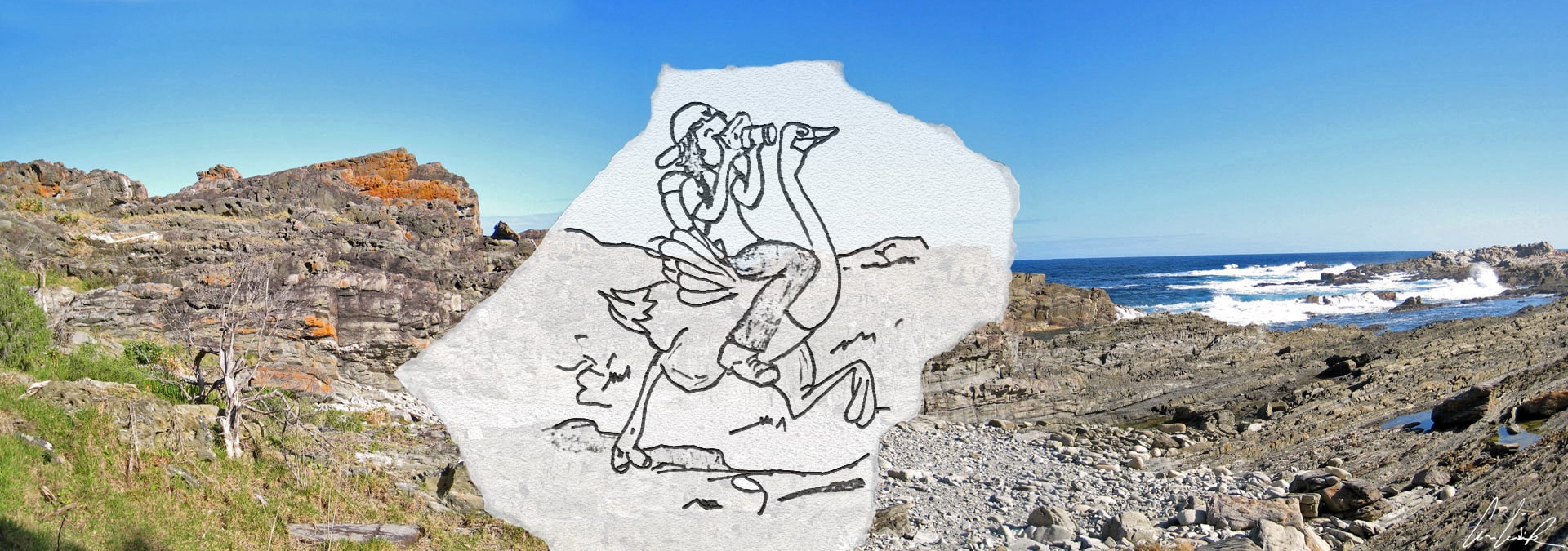

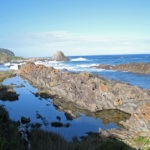
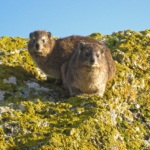

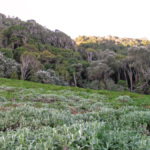


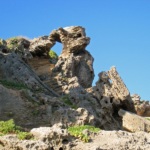

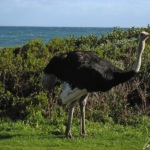
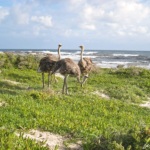
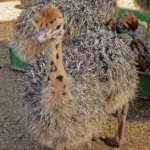

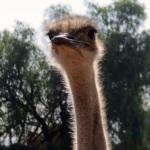
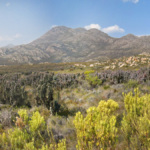
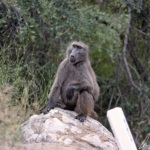


Beautiful images!
Why did the ostrich boom start in South Africa? And, I was always wondering if the cartoon depiction of them hiding the head is true or not, but, I guess, with that brain size might as well be 🙂
Thank you :-). Seeing the potential, the farmers of the Oudtshoorn district pioneered the domestication of ostriches in the 1850’s ! They immediately realised that farming ostriches were far more profitable than any other activity, ripped out their other crops and planted lucerne !
Ostriches bury their heads in the sand when they’re scared or threatened is a myth 🙂 It’s an optical illusion! Ostriches are the largest living birds, but their heads are pretty small. If you see them picking at the ground from a distance, it may look like their heads are buried in the ground.
Great pictures! There’s so much variety in South Africa
Thank you :-). And I fully agree there’s a lot to see and to do… hiking, breathtaking landscapes, amazing sceneries !
I’ve just learned so much about ostriches now haha. Thanks so much for this!
Thank you ! The ostrich is the world’s largest, heaviest and fastest bird 🙂 but I’m not sure this bird have a spark of intelligence, ha, ha !
The pictures are fantastic for sure. I am also really excited about all the cacti around. I love them so much. We really want to visit South Africa. Thank you for sharing.
The climate of the Little Karoo is markedly different from that of the coastal Garden… The vegetation is remarkably diverse, featuring renosterveld, mountain fynbos, Karoo-veld and numerous geophyte species.
Wow, loved learning about the wildlife. I really want to visit South Africa and your writing was really inspiring. (it’s amazing how similar Afrikaans looks to Dutch at least what you wrote!)
You should definitively see South Africa by yourself at least once 🙂 ! Afrikaans is a daughter language of Dutch… The question is “can Dutch and Flemish people understand Afrikaans?”. Apparently, the answer is mostly, yes ! However, there are some funny differences: if a Dutchman “amper” catches the train, he is sitting in the train. An Afrikaner who “amper” catches the train is left standing on the station! “Amper” means “just barely” in Dutch, but “almost” in Afrikaans…
Beautiful pictures!! Can’t wait to visit South Africa and see this for myself. Thank you for sharing your adventure.
Thank you for your lovely comment. I always live in the moment each trip I make !
I’m glad you enjoyed your time in my home country. I was in the Oudtshoorn area a few months ago but it was raining so I couldn’t get any good pictures. Yours are great though.
We were really lucky with the weather :-). It helps to take nice pictures ! We had a great time at Oudtshoorn & the Little Karoo region is impressive… Love to come back to discover more the area !
I need to get back to South Africa to do the Garden Route! There is so much I missed out on!
So do I :-). There areso many amazing places to see, great people to meet, delicious food to eat !
I have always wanted to do something like this!! Your pictures are amazing and I can’t wait to (hopefully) see it for myself one day!
An extraordinary adventure I recommend to you 🙂 Oceans, mountains, deserts, and flowers, prosperous cities and townships, the Republic of South Africa is a nation made up of the colors of the rainbow. So you should definitively see it by yourself at least once !
This national park looks beautiful. I’d love to explore and hike around it. The Blue Duiker’s look so adorable. Did you see many or are they quite rare?
South Africa is full of so many amazing places to see, great people to meet, delicious food to eat etc. so see it by yourself at least once ! Hardly larger than a scrub hare, Blue duikers live a secretive life in forests and thickets. But there is some places where you’re practically assured of a sighting 🙂
Oh I’d love to try the seafood! My favorite kind of food! 🙂 Aaaaand I guess I’ll have to go look at plane tickets now 😉 Thanks for the fun read!!
I’m so glad to inspire you to be adventurous and to enrich your life by exploring South Africa… 🙂
What an informative post – I am so intrigued by South Africa, I need to get down there for a visit!
Thank you. I hope you will have a chance to see South Africa by yourself at least once ! It’s such a beautiful country 🙂
I love your pictures. I never thought about eating Ostrich meat. That’s an interesting concept.
What a stunning post! I have had emu meat and its delicious. I hope ostrich is good too!
First of all, thanks for the article! I have been thinking about South Africa in a while and this article made me add SA to the top of the list. I have never tried Ostrich meat before and I’m curious to try when I’m there. And I heard their cuisine is amazing.
Actually I didn’t know anything about this animal before reading you post 🙂 So thank you for informing me hahaha Your pics are amazing
Ostrich can be consumed without moderation will be in my head all day. I have never eaten it but I heard all the same points you stated. I would love to visit Africa and to even see the wildlife would be a bonus!
Wow 7 rivers! That is crazy! I love all the wildlife that you can see here!
Oh my these photos are beautiful. I have never seen an ostrich in a natural habitat. They are truly magnificent creatures.
These are some amazing photos! I’ve never been to South Africa before. I need to get there one day.
That rocky shore is absolutely gorgeous! I would love to visit that! And that blue duiker….how cute! These all sound like amazing places.
Those photos are gorgeous. What an insightful read, I didn’t know a lot of this and I certainly didn’t know there was such things as an Ostrich farm. I don’t know why though as I have had Ostrich before so it stands to reason it would be farmed.
These pictures look incredible! Ostriches were one of my favourite animals to spot when I was in Kenya and Tanzania. I’d love to visit South Africa one day and see them again!
Love to know more of fauna and avi fauna. And for the ostrich I loved this post, I always had fantasy for these big birds. South Africa is a wonder when it comes to wildlife.
http://www.mommyinme.com
I have gone for a safari sometimes back in Kenya, but I have never seen an ostrich before. Great article. Thank you for sharing.
Very interesting topic! Your words and photos made me want to visit South Africa. Thanks for sharing!
Wow, Thank you for sharing these photos! Have yet to visit South Africa so I’m living through these photos you have here! Would love to visit that endemic forest and see the Blue Duiker up close
South Africa is indeed a beautiful country. This is still on my bucket list and seeing your pictures makes me wanna go there immediately. I wish hopefully this year I can see the beautiful landmarks there.
I love ostrich. And it would be a great trip to visit them in Africa. A bucket list – but probably not happening – item for sure. That natural habitat would be so great to photograph.
And their houses shall be full of doleful creatures; And ostriches shall dwell there, And satyrs shall dance there.